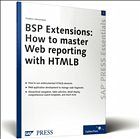Nicht lieferbar

BSP Extensions: How to master Web reporting with HTMLB
SAP PRESS Essentials 1
Versandkostenfrei!
Nicht lieferbar
Optimize the use of the BSP extensions HTMLB, XHTMLB, and PHTMLB, using the expert guidance found in this unique technical guide - the first in the SAP PRESS Essentials series.First, benefit from detailed advice on the practical implementation of each of the various elements. Then, after designing a BSP application with its pages and page fragments, learn how to develop the numerous functions such as hierarchical navigation, table selection, detail display, comprehensive search templates, easy-to-use input administration and much more.In addition to the standard elements from the BSP extension...
Optimize the use of the BSP extensions HTMLB, XHTMLB, and PHTMLB, using the expert guidance found in this unique technical guide - the first in the SAP PRESS Essentials series.
First, benefit from detailed advice on the practical implementation of each of the various elements. Then, after designing a BSP application with its pages and page fragments, learn how to develop the numerous functions such as hierarchical navigation, table selection, detail display, comprehensive search templates, easy-to-use input administration and much more.
In addition to the standard elements from the BSP extension HTMLB such as gridLayout, tree and tableView, you'll also get a firsthand look at the new BSP extensions XHTMLB and PHTMLB, including their complex elements such as formLayout, tabStrip and overflowContainer, just to name a few.
Many of these extension elements have been insufficiently documented, or simply undocumented, therefore, a comprehensive list of all tags used is included, along with their specific attributes, in the appendix.
Highlights include:
- gridLayout: Positioning text and layout components
- tree: Hierarchical tree structures
- checkbox and radioButton: Selection elements
- textEdit: Multi-line input fields
- overflowContainer: Resolving overflow situations
- formLayout: Generic positioning elements
- tableView: Presenting tables
- Event Handling
Table of contents:
1. Introduction ... 3
1.1 About the Contents ... 3
1.2 Scenario ... 3
1.3 About BSP Applications ... 4
1.4 BSP Extensions ... 5
2. Starting Out ... 9
2.1 Package and Application ... 9
2.2 Design and Layout ... 10
2.3 Application Class ... 11
2.4 Pages and Page Fragments ... 11
2.5 Delta Handling ... 12
3. Elements ... 15
3.1 content, page, document, and form ... 15
3.2 gridLayout ... 16
3.3 image and textView ... 18
3.4 tree ... 20
3.5 Event Handling ... 27
3.6 checkbox and radioButton ... 33
3.7 Remark I: Conceptual Considerations ... 36
3.8 Remark II: Making Code Fragments Persistent ... 37
3.9 textEdit ... 41
3.10 button and horizontalDivider ... 43
3.11 group, tray, and tabStrip ... 48
3.12 overfl owContainer ... 52
3.13 formLayout ... 53
3.14 inputField and label ... 64
3.15 tableView ... 67
4. Conclusion ... 73
5. Appendix ... 77
Index ... 95
First, benefit from detailed advice on the practical implementation of each of the various elements. Then, after designing a BSP application with its pages and page fragments, learn how to develop the numerous functions such as hierarchical navigation, table selection, detail display, comprehensive search templates, easy-to-use input administration and much more.
In addition to the standard elements from the BSP extension HTMLB such as gridLayout, tree and tableView, you'll also get a firsthand look at the new BSP extensions XHTMLB and PHTMLB, including their complex elements such as formLayout, tabStrip and overflowContainer, just to name a few.
Many of these extension elements have been insufficiently documented, or simply undocumented, therefore, a comprehensive list of all tags used is included, along with their specific attributes, in the appendix.
Highlights include:
- gridLayout: Positioning text and layout components
- tree: Hierarchical tree structures
- checkbox and radioButton: Selection elements
- textEdit: Multi-line input fields
- overflowContainer: Resolving overflow situations
- formLayout: Generic positioning elements
- tableView: Presenting tables
- Event Handling
Table of contents:
1. Introduction ... 3
1.1 About the Contents ... 3
1.2 Scenario ... 3
1.3 About BSP Applications ... 4
1.4 BSP Extensions ... 5
2. Starting Out ... 9
2.1 Package and Application ... 9
2.2 Design and Layout ... 10
2.3 Application Class ... 11
2.4 Pages and Page Fragments ... 11
2.5 Delta Handling ... 12
3. Elements ... 15
3.1 content, page, document, and form ... 15
3.2 gridLayout ... 16
3.3 image and textView ... 18
3.4 tree ... 20
3.5 Event Handling ... 27
3.6 checkbox and radioButton ... 33
3.7 Remark I: Conceptual Considerations ... 36
3.8 Remark II: Making Code Fragments Persistent ... 37
3.9 textEdit ... 41
3.10 button and horizontalDivider ... 43
3.11 group, tray, and tabStrip ... 48
3.12 overfl owContainer ... 52
3.13 formLayout ... 53
3.14 inputField and label ... 64
3.15 tableView ... 67
4. Conclusion ... 73
5. Appendix ... 77
Index ... 95



